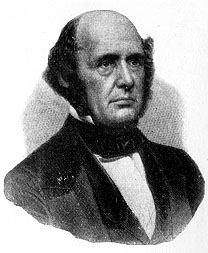Springfield, Massachusetts, by Clarence E. Blake, Ph.D., continued.
 Left: George Ashmun. Left: George Ashmun.
ceeding for which something might be said. The town authorities assigned seats in church according to "worldly condition and social importance," and we need not be told that there were heartaches and feuds resulting from this.
The first consideration of course had been for a church; and the first pastor, Rev. George Moxon, exercised a strong influence in the early Springfield days. The fourth pastor was the Rev. Robert Breck. A dispute had arisen previous to his installation over some of his theological views. A neighboring "conference" objected to having a minister with such views settled over a church in its vicinity, and strove to stop the proceedings. No course was open but an appeal to the courts; and during the deliberations of the installing council, a constable came into the assembly and arrested Breck, on a warrant charging him with heresy. The installing council was left with no candidate to install. Mr. Breck remained in the custody of the officers a day and a night, when the judges decided in his favor and he returned for installation. The original plan was to arrest the whole council; but to this the magistrates would not listen, and no warrants could be obtained.
Soon after the Revolution, Springfield was a centre of serious disturbances connected with Shays's Rebellion. Those disturbances culminated in an attack on the Arsenal, Jan. 25, 1787, and
its repulse. The rebellion found few active supporters among the inhabitants of Springfield. The insurgents were mostly from the small towns in the country round about. There was some

The Old Parsons Tavern in 1776
-- Page 3 --
© Laurel O'Donnell 1998 - 2005, all rights reserved
This document may be downloaded for personal non-commerical use only
and should not be reproduced or distributed without permission.
|

 Left: George Ashmun.
Left: George Ashmun.